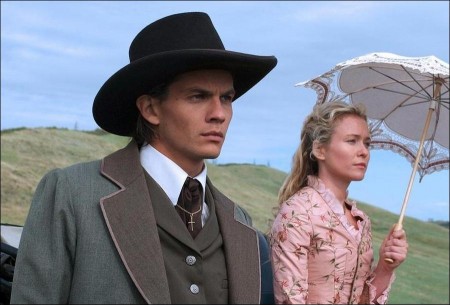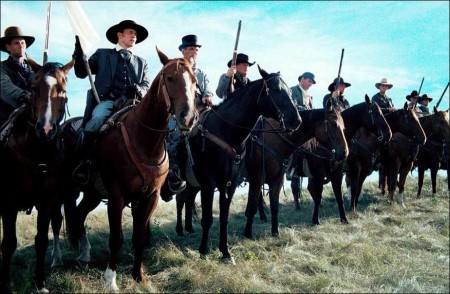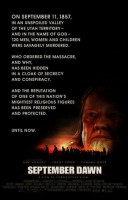On September 11, 1857 in an unspoiled valley of the Utah Territory—and in the name of God—120 men, women and children were savagely murdered. Who ordered the massacre, and why, has been hidden in a cloak of secrecy and conspiracy. And the reputation of one of the nation’s mightiest religious figures has been preserved and protected. Until now.
Captain Alexander Fancher (Shaun Johnston) is leading his third wagon train overland to California in the spring of 1857. For Fancher, an Arkansas militiaman, it would be his last trip, as this time he is bringing his family with him to settle down on the rich Gold Coast of California. Mormon Bishop Jacob Samuelson’s (Jon Voight) family compound just outside Cedar City, Utah is home to his many wives and children, particularly his beloved oldest son, Jonathan (Trent Ford), and adored second son, Micah (Taylor Handley).
Run out of Missouri a decade earlier, victims themselves of massive persecution, including the murder of their Prophet Joseph Smith (Dean Cain), the Mormons are now on edge when “Gentiles”—a term used by the Mormons for anyone not of their faith—cross into their territory. Rumors are circulating that President Buchanan is sending US Army troops to displace Territorial Governor Brigham Young (Terence Stamp) from his post. Young, in turn, has declared martial law, warning his church members to be prepared to turn back interlopers by any means.
When the Fancher wagon train stops in Mountain Meadows in early September, they are first met by Mormon deacon John D. Lee (Jon Gries) and his Danites (a group of extreme LDS vigilantes). Urged by Lee to leave the encampment, Fancher stands fast and continues to plead for compassion, as his teams need to refresh and rest.
Bishop Samuelson intervenes and allows the wagon train to stay in the valley for two weeks. The Bishop commands Lee to offer help to the settlers, while at the same time instructing his son Jonathan to spy on them, hoping to ascertain their true intent. In the meantime, the Bishop makes his way to the Elders in Cedar City and asks for divine guidance.
Jonathan is only too happy to accommodate his father’s wishes, for he was captivated the first day by the angelic smile of a beautiful young girl on the wagon train. The minister’s daughter, Emily (Tamara Hope) and her family are traveling with the wagon train on their way to a new life. Generous in spirit and kind in nature, Emily helps the settlers by caring for the younger children on the train.
As his time among the Gentiles extends, Jonathan is fascinated, not only by Emily, but by Fancher’s pure bloodline horse stock. One horse in particular catches Jonathan’s eyes—an unbreakable yet striking stallion of extraordinary power. Possessing an unusual gentleness with horses, Jonathan showcases his horsemanship to Fancher and others (including Emily) as he quietly wins the horse over.
By the time the Bishop returns to the encampment, Jonathan and Emily have declared their love and commitment to each other. Still, Bishop Samuelson has other plans. The Church declares the wagon train to be enemy combatants who must be killed. Against Church teachings, as the Bishop incites his followers to prepare for the blood atonement of those killed earlier in Missouri, Jonathan urgently and frantically tries to quell the fury.
Unable to make his father see reason, Jonathan and Emily have one last moment where they can share their commitment and Jonathan’s pledge to move with her to California. The two young lovers share tokens of their promise and privately bond themselves to each other.
Planning to slip away at dawn to join the wagon train, Jonathan is instead ambushed by his father, locked up in chains and is anxiously close to being killed himself. Desperate to escape, it isn’t until a bloody and deranged Micah pleads with Jonathan to stay clear of the ensuing horror that Jonathan realizes the full weight of his father’s actions.
Jacob first persuades the local Paiute Indians to attack the wagon train, accompanied by some of his own men disguised as Indians. The settlers are able to repulse the onslaught and, after losing many of his own men, the Indian chief withdraws, realizing that he has been duped by the Bishop.
As the settlers help their own wounded and wait for the next onslaught, John D. Lee comes to them under a flag of truce. Telling them that he will lead them to safety if they will follow him and leave their wagons and possessions behind, he instead leads them into a brutal ambush.
When Jonathan can at last escape and make his way to the encampment site, he encounters a scene more vicious than any from Dante’s Inferno. Horrified at the sight, a distraught Jonathan begins the torturous search for Emily among the bodies. What he finds will put him squarely in the crosshairs between love and death—and test the will of God against the will of man.
Production Notes
“September Dawn” is a dramatic recreation of historical events that occurred in the fall of 1857. The religious fanaticism, betrayal and subsequent massacre that serve as a background to the Romeo and Juliet love story are a tragic part of America’s history.
The film started as an idea that “tickled” Chris Cain’s brain and made him think. Enjoying a comfortable retirement in the mountains of Colorado, the director had no intention of doing anything more than writing a screenplay or two that he figured he could sell. That was until Carol Whang Schutter told him about the Mountain Meadows Massacre, one of the most tragic and horrific events in American history. Cain found himself intrigued by the possibility of a cinematic tale hidden in the real life events and set out to find a way to tell the story.
“I came up with the Romeo and Juliet idea, to personalize the event.” As Cain started doing the research, he discovered that this slaughter occurred, in a strange coincidence, on September 11, 1857. It was then he began to draw on the many parallels and similarities between what is happening in today’s world of religious fanaticism with the attitudes that led to the grisly events of that September morning 150 years ago.
“You watch the news and you wonder what makes people today do what they are doing. You ask yourself, what makes a kid strap a bomb to himself, go to a public place and blow it up. And then you read Brigham Young’s speeches and what he’s saying and you see his ability to fire people up to do things. This flashes back to the days of Hitler and Jim Jones and the Kool-Aid party and you think that world of religious fanaticism can be a very scary thing,” says Cain.
Pertinent today
“The story is so pertinent today because people look at recent events world wide that are born of religious fanaticism as if it is something new. They should know that 150 years ago, it happened right here on American soil.” Cain goes on and qualifies, “Having said that, religions also build hospitals and schools, educate people and takes care of the poor.”
Making the decision to finance the film privately to be free of artistic compromise, Cain quietly put together the budget and shot the film independently in Calgary, Canada. “It was important that there wouldn’t be a false note in it – if I had to shoot someone in the head, it wasn’t going to be a flesh wound. There was no way to stumble through this story.”
Cain was determined to portray the historical facts accurately and looked to many sources on which to base his script. He settled on a 27-page confession by John D. Lee, the only person convicted for his part in the carnage. He also tapped the actual transcripts of Brigham Young’s speeches and sermons from the time.
“If any miserable scoundrels come here, cut their throats,” was the message in Young’s “Blood Atonement Sermon” found in the Journal of Discourses, Vol. II, page 311. Using the Mormon leader’s own words, Cain incorporated that attitude into the script, “Young’s words are taken verbatim from his preaching, sermons and writings. I don’t think I would have believed the things that were being said at the time, if they hadn’t been historically and factually recorded,” Cain observed. “But, you can look up the quotes.”
Citing more research directly from The Church’s archives, Cain noted, “The other document that was the most damning was Brigham Young’s deposition. If you read his deposition and compare that to what was coming out of his speeches at that time, clearly he was urging this kind of behavior. At the same time Young is saying that he knew nothing about the massacre.” From what Cain surmised, this was not true, as illustrated in a quote from one of Young’s transcripts where he says, “I will loose the Indians on them, we will slit their throats from ear to ear.”
Young also declared himself to be “the voice of God, and anyone who doesn’t like it will be hewn down.” He even commanded his followers to “take a solemn oath to never discuss this, even among ourselves.”
A message from above
Turning to the Lee confession, Cain found that Lee stated, in plain language, the circumstances surrounding what happened leading up to the massacre as well as the event itself. “Lee describes persuading the Paiute Indians to attack after getting this message from above (God), telling him exactly what to do, how to approach the settlers, deceive them with the white flag, and lead them into slaughter. At first, he resisted it, but did it anyway, because he was told to. So that was the document that told me how to stage the end of this movie.”
The confession, Cain explains, states specifically how the member of the wagon train marched single file, babies and the kids in one wagon and the guns in another. Women marched single file ahead of the men and the men marched single file, which is exactly how it is done in the movie. “I believe his documents because he is the only person who was there who wrote anything that has any relevance to the case.”
Cain wanted the look of the location to be a part of the story as well. “I wanted our locations to very much resemble Mountain Meadows where the massacre took place. The area where we shot was just a little greener and doesn’t have the sagebrush. There was also a big river and the actual place had a little stream.”
Relying on his Academy Award nominated production designer Rick Roberts, Cain felt he more than met the film’s needs. Why did he film in Canada? “Because it isn’t Utah,” he says, knowing the controversy this film would cause in the Mormon state.
Cain also chose the Canadian location for the infrastructure of people who were available to staff the crew. He praised the quality of the crews and attributed that to the amount of filming occurring in the area. “We got the cream of the crop with everybody, probably the best crew I ever had. Everything I needed was up there; from the people who provided the wagons, and probably own the most extensive group of western wagon, buggies and tents, to all the props for this type of film. We had all the cast, horses and the stock and anything else you needed, including the wide open spaces.”
Cain concluded, “This movie is about two people coming from two very different groups and two very different ways of life. It becomes quite difficult to understand somebody with whom you have absolutely no frame of reference regarding their sensibility, their background, their upbringing. There are such strong parallels to today’s world. But this film is about tolerance. We all could learn from the destruction and heartbreak that violence brings to all.”
Production notes provided by Black Diamond Pictures.
September Dawn
Starring: Jon Voight, Trent Ford, Tamara Hope, Terence Stamp, Lolita Davidovich, Dean Cain, John Gries, Taylor Handley, Krisinda Cain, Shaun Johnston
Directed by: Christopher Cain
Screenplay by: Christopher Cain, Carole Whang Schutter
Release Date: August 24th, 2007
MPAA Rating: R for violence.
Studio: Black Diamond Pictures
Box Office Totals
Domestic: $1,066,555 (100.0%)
Foreign: —
Total: $1,066,555 (Worldwide)


